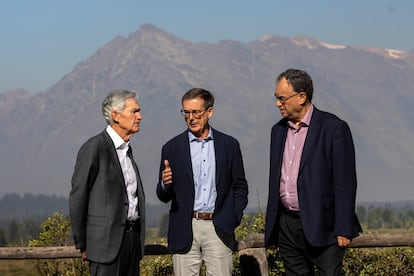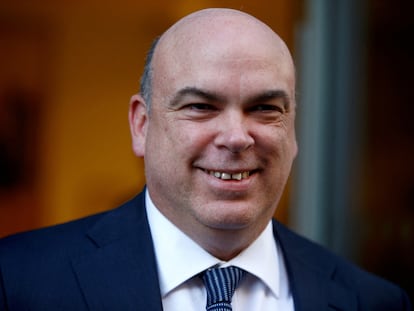From fighting inflation to avoiding recession: Monetary policy changes direction
Jackson Hole meeting confirms that central banks’ concerns have shifted from prices to employment and economic activity in search of an elusive soft landing

The missions of the Japanese SLIM probe and the American Odysseus module this year demonstrated how difficult it is to achieve a soft landing on the Moon. This term from the space race was adopted by the Federal Reserve to describe the concept of curbing inflation without causing a recession that would trigger a sharp rise in unemployment. In the economy, a soft landing is almost as difficult to achieve as it is on the Moon. It has been the goal of Fed chairman Jerome Powell for more than two years. Now that inflation has lost altitude, the fear is that the ship will run out of fuel. This is leading to a change of cycle in monetary policy, as confirmed this weekend at the Fed’s annual economic conference in Jackson Hole, Wyoming. Powell will soon follow the path of rate cuts taken by his colleagues at the European Central Bank (ECB) and the Bank of England.
“The time has come,” were the words used by the U.S. central bank chief on Friday to mark the turning point. It was practically a commitment that he will lower the price of money at the Fed meeting on September 18. The long-time Bundesbank president Karl Otto Pöhl used to say that inflation is like toothpaste: once it is out of the tube, it is very difficult to put it back in. But after three years, Powell believes he has almost achieved it. “My confidence has grown that inflation is on a sustainable path back to 2%,” he said on Friday.
The Jackson Hole gathering analyzed the extraordinary nature of the latest global inflationary phase, in which demand distorted by stimulus programs and savings accumulated since Covid lockdowns collided with the strangulation of supply due to supply chain bottlenecks and the war in Ukraine, among other factors. Across the world, that phase, which has been much less transitory than central bankers initially expected, now seems to be behind us.
With the notable exception of the Bank of Japan (where rates are rising), the world’s major central banks appear to be aligned in their policy of lowering the price of money. Although there is some internal division, the ECB seems willing to lower rates again in September, according to statements made by some members of its board at Jackson Hole. Finland’s Olli Rehn said that the process of disinflation in the eurozone is underway, while “the growth prospects in Europe, especially in the manufacturing sector, are rather moderate.” This reinforces the arguments in favor of a rate cut in September, he concluded. Mario Centeno, governor of the Bank of Portugal, said that it was an “easy” decision, given the data on inflation and growth, although his Austrian colleague Robert Holzmann expressed his reservations and assured that a rate cut is not a “foregone conclusion.”
Andrew Bailey, governor of the Bank of England, was “cautiously optimistic that inflation expectations are better anchored.” Although he warned that it is “too early to declare victory,” his words suggest that he will also continue to lower rates, as he did by a quarter of a point at the beginning of the month for the first time in three and a half years, down to 5%. The central banks of Canada, New Zealand and China are also easing their monetary policy after managing to contain prices.
Lessons learned
In this phase of high inflation, Powell has repeatedly recalled what happened to Arthur Burns, chairman of the Federal Reserve in the 1970s. Burns was tolerant of inflation, which became entrenched in the American economy for a decade. It was his successor, Paul Volcker, who put a stop to prices with aggressive rate hikes that triggered a recession. Powell, an admirer of the latter, was willing to pay that price.
Two years ago, also at Jackson Hole, Powell said there would probably be “some pain” for families and businesses, but that he would not give up on his efforts to control inflation and that he would “keep at it” until the job was done. (Keeping At It is the title of Volcker’s memoir.) Last year, at the same symposium, Powell again brought out his hawk’s claws, predicting higher rates for longer. But now, “the time has come” to lower them.
The U.S. Congress has given the Federal Reserve a dual mandate to seek price stability and full employment, unlike the ECB, which has only the former as its guiding light, at least in theory. After three years with a strong labor market, Powell believes that “the upside risks to inflation have diminished. And the downside risks to employment have increased.” Inflation has fallen below 3% for the first time since March 2021, while unemployment has climbed almost one point in a year to 4.3%, although it remains at historically low levels.
The main takeaway from Powell’s speech at Jackson Hole is that the central bank will not tolerate further weakness in the labor market, said analysts at Oxford Economics. This increases the chances of more aggressive monetary policy easing.
A gradual reduction
Barring a negative surprise in the jobs data in the coming weeks, Fed members are leaning toward a measured approach to rate cuts, which would include a 0.25-point cut in September, followed by others in November and December. Boston Fed President Susan Collins said she expects “a gradual and methodical pace” of cuts, and Philadelphia Fed President Patrick Harker said the same.
Powell, however, did not use the word “gradual” but instead underlined that “the current level of our policy rate gives us ample room to respond to any risks we may face, including the risk of unwelcome further weakening in labor market conditions.”
The market sees a 76% chance for a 0.25-point cut and a 24% chance for a 0.50-point cut, according to CME’s FedWatch tool. At the Fed’s September meeting, members will also publish a new set of economic projections and indicate where they expect the policy rate to be at the end of each year through 2026.
The United States has so far avoided a recession that many saw as inevitable, and Powell remains confident that rate cuts will prevent one.
Sign up for our weekly newsletter to get more English-language news coverage from EL PAÍS USA Edition
Tu suscripción se está usando en otro dispositivo
¿Quieres añadir otro usuario a tu suscripción?
Si continúas leyendo en este dispositivo, no se podrá leer en el otro.
FlechaTu suscripción se está usando en otro dispositivo y solo puedes acceder a EL PAÍS desde un dispositivo a la vez.
Si quieres compartir tu cuenta, cambia tu suscripción a la modalidad Premium, así podrás añadir otro usuario. Cada uno accederá con su propia cuenta de email, lo que os permitirá personalizar vuestra experiencia en EL PAÍS.
¿Tienes una suscripción de empresa? Accede aquí para contratar más cuentas.
En el caso de no saber quién está usando tu cuenta, te recomendamos cambiar tu contraseña aquí.
Si decides continuar compartiendo tu cuenta, este mensaje se mostrará en tu dispositivo y en el de la otra persona que está usando tu cuenta de forma indefinida, afectando a tu experiencia de lectura. Puedes consultar aquí los términos y condiciones de la suscripción digital.
More information
Archived In
Últimas noticias
Human rights activists, opposition members, and a minor: Maduro’s other political prisoners
Israel sparks a civil war within the MAGA movement
The complicated life of Francesca Albanese: A rising figure in Italy but barred from every bank by Trump’s sanctions
Pinochet’s victims grapple with José Antonio Kast’s rise in Chile
Most viewed
- Reinhard Genzel, Nobel laureate in physics: ‘One-minute videos will never give you the truth’
- Pablo Escobar’s hippos: A serious environmental problem, 40 years on
- Charles Dubouloz, mountaineering star, retires at 36 with a farewell tour inspired by Walter Bonatti
- Why we lost the habit of sleeping in two segments and how that changed our sense of time
- The Florida Keys tourist paradise is besieged by immigration agents: ‘We’ve never seen anything like this’











































